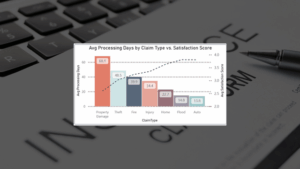Any well-seasoned businessperson can tell you that marketing is a vital component of driving business revenue. But traditional marketing principles don’t account for modern technology and data-driven strategies. Consider: Most marketing classes focus on “The Four Ps”: price, place, promotion, and product. But what about integrating business intelligence (BI) tools?
Here’s a look at how to incorporate BI tools into marketing decision-making to drive truly data-driven campaigns—and results:
5 Steps to Bring the Scientific Method to Marketing
By incorporating data and analysis into the marketing process, you can take a scientific, data-driven approach to better identify your customer value proposition and build optimized campaigns founded on quantifiable evidence.
Remember learning the scientific method back in school? Here’s how you can apply the same tactics to marketing to create data- and analysis-driven campaigns:
1. Hypothesis: Define the Problem
First, identify the problem. This is easier said than done. Specifically, you need to distinguish between the true problem (i.e., the root cause) and the symptoms of the problem (i.e., simple, surface-level manifestations). For example, suppose you want to solve the problem of a recent drop in sales. At a closer look, you realize that the drop in sales is really just a symptom. The true problem is whatever is causing the drop in sales. That is the variable you need to solve for and the question you need to answer.
Meanwhile, use this time to determine your research objectives. By clearly outlining your research plan, you can narrow the focus and ensure your inquiries are aligned with the problem you want to solve.
2. Analyze the Situation
Before diving into data collection, take the time to evaluate the internal and external factors influencing the problem.
Take the above example about identifying the cause for a drop in sales. Consider current market conditions, competitor activities, and customer behavior that might affect consumer demand or otherwise influence marketing decisions. Internally, you can look at company performance metrics, sales data, and recent marketing efforts to identify potential strategy weaknesses or operational inefficiencies.
3. Collect Problem-Specific Data
It’s important to collect two kinds of data: quantitative and qualitative. By combining the two, you’ll be able to create a more comprehensive analysis that considers the hard numbers as well as the deeper context behind those numbers.
Similarly, be sure to include both primary data and secondary data. Remember that primary data is collected specifically for your research, while secondary data includes information from existing sources.
- Quantitative: in-depth interviews, focus groups, direct observations
- Qualitative: case studies, open-ended interview responses
- Primary: personal observations, surveys, ethnographic studies
- Secondary: industry reports, competitor analyses, government publications
4. Interpret Data
Next, as you interpret your data, pay attention to potential trends, biases, and anomalies that could compromise your analysis and conclusions.
- Population: Does your sample accurately reflect the broader group you want to study?
- Validity: Are you measuring what you intended to measure?
- Sample: Does your sample size represent your target population?
- Confidence intervals: What margin of error are you willing to accept in your results?
You can also use tools like Power BI to assist in data interpretation. For example, Power BI can translate datasets into easy-to-read charts and graphs to help with data visualization so you can more easily highlight trends.
5. Solve the Problem
Finally, use your data and interpretations to develop a possible solution(s) for your problem. Based on your analyses, you may come up with several different options to try out. In this case, prioritize solutions that can deliver measurable outcomes so you can more easily track your progress moving forward.
How a BI Team Can Level Up Your Data Analysis
While the above steps outline a DIY approach you can take to data analysis to help improve your marketing decision-making, partnering with a BI team can strengthen your analysis and help you better understand—and use—your data.
Here’s how we can help your business unlock the data you need to optimize your marketing efforts
Gather requirements to help clarify the problem
To kick off the process, share your first thoughts on the problem you want to solve. It’s okay if you’re not exactly sure what the root cause of that problem is. It helps to bring examples of the outcome(s) you’d like to achieve, along with any other materials that can give additional background, such as case studies or prior analyses. This information helps our BI team better understand the context and your desired results.
With this information, we can help you clearly define your business needs. In other words, we identify:
- the key problem to solve
- what question to answer
- desired outcomes
Basically, we help you turn your problem into a clear, actionable question so we can start searching for the answer that will help you meet your goals
Using data warehousing to source data
Our BI team helps you gather and centralize all the necessary information required to drive data-based decision-making. Specifically, we use data warehousing to centralize data from multiple sources.
Usually, the majority of the data used for analysis is focused on your own business, but it can also be helpful to include data about your competitors to make comparisons against industry benchmarks and identify more areas for improvement.
Analyzing data to develop strategic solutions
Finally, our BI team internally interprets the data through the data warehouse to perform advanced analysis. This analysis includes:
- Semantic modeling: to ensure data relevance
- Data modeling: to visualize relationships between variables
- Reporting: to communicate insights and make the findings actionable
At this stage, we use a development environment to complete all testing before applying changes to the front-end user through the production environment.
By working in a separate, controlled environment, we can test new updates and processes to ensure they function as desired without error. Once this testing is complete, only then do we implement the changes in the production environment and make it live for. This way, we can guarantee the data we provide to you is always relevant, accurate, and up to date, minimizing the risks of future errors, inaccuracies, or downtime.
Long-Term Partnerships for Continuous Improvement and Ongoing Success
In business, as in life, when one problem is solved, there’s almost always another one right behind it. That’s why a foundational component of all BI processes is adaptability; you need to regularly revisit your analyses and redefine new strategies as needed based on new data to adapt to your evolving business challenges and goals.
At LeapFrogBI, we highly value the relationship we build with our clients through this intensive, collaborative process—and we understand that adaptability is an important part of your business’s long-term success. That’s why our systems are designed with flexibility, so we can revisit and address any new requests you have at any stage of the process, whether we need to incorporate new data or even modify the original problem.
It All Starts with Data: From Problem-Defining to Problem-Solving
Although these terms may sound distinct and separate, marketing, data analytics, and business intelligence are, in fact, deeply connected. By integrating data analytics and business intelligence processes into your marketing strategy development, you can more clearly identify problems and answer critical business questions to devise solutions that improve your marketing campaigns.
At LeapFrogBI, what we love about working with data is its dual purpose. We know that data helps you better answer business questions. But even before that, it helps you figure out how to ask the right questions. After all, you can’t solve a problem unless you can correctly define it first. And to do that, you need to ask the right question. That’s when you need to look to the data.
The Dual Purpose of Data | |
Define the Problem | Solve the Problem |
|
|
Unlock the Power of Your Data
Data may be the key to identifying and realizing new opportunities for marketing growth strategies, but it’s not always easy to know where to begin. At LeapFrogBI, we help you understand your data and make it work for you to power truly data-driven decision-making that moves the needle on your business goals.








